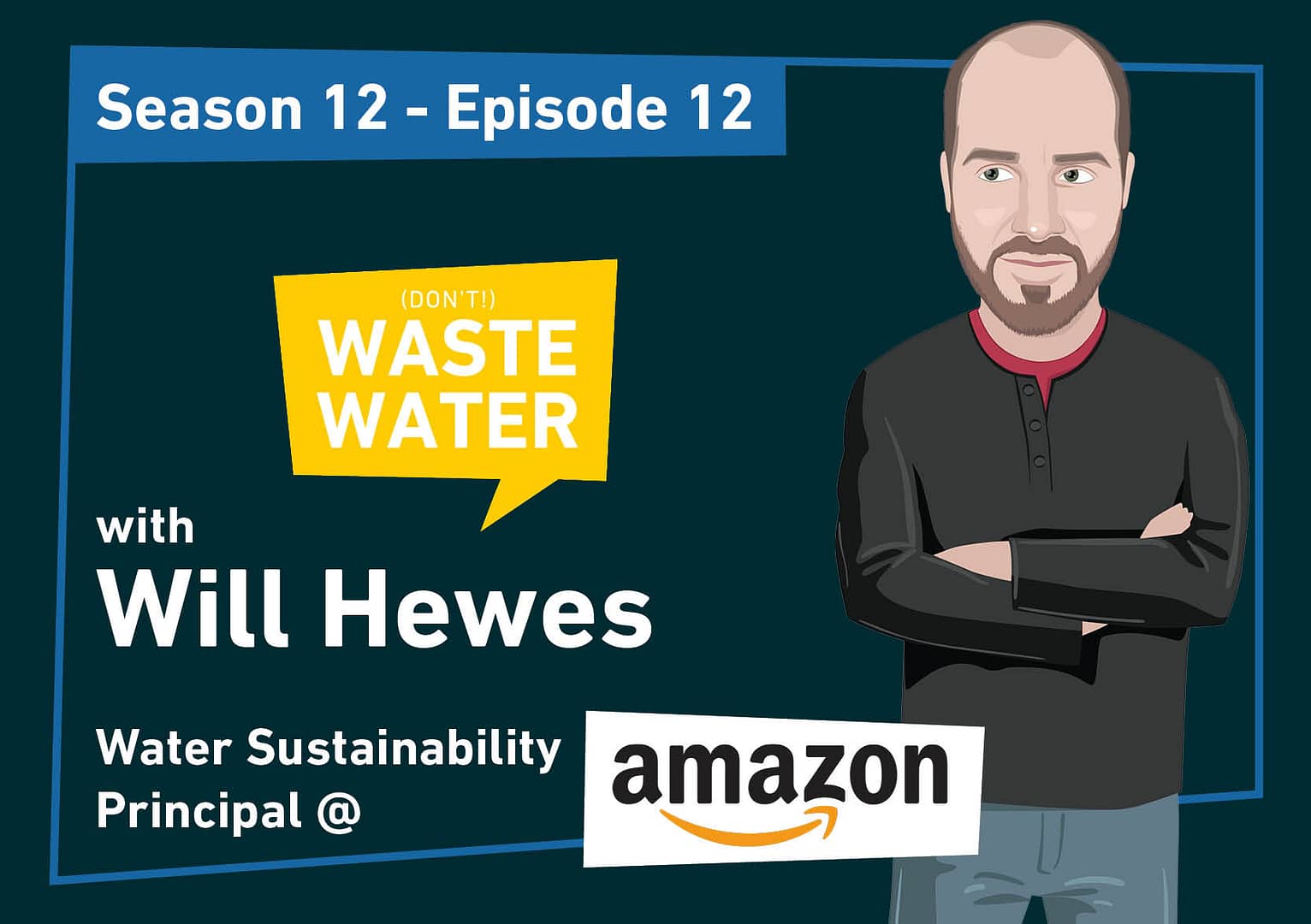Deep in the heart of Seattle, a company that began by selling books now wields unprecedented influence over global water resources. Amazon’s massive data centers gulp millions of gallons daily, while its sprawling fulfillment networks leave hydrological footprints across continents. But beneath this water-intensive reality lies a fascinating story of innovation, as the tech giant deploys cutting-edge solutions to balance growth with water stewardship. From advanced cooling systems to watershed restoration projects, Amazon’s water journey offers valuable insights for water industry leaders seeking to navigate the intersection of technology, sustainability, and business growth.
with 🎙️ Will Hewes, Water Sustainability Principal at Amazon
Take-home message (in 2 long sentences 😅):
Amazon is a tech behemoth that transformed from an online bookstore into a global marketplace, cloud computing titan, and AI innovator, all while making efficiency their competitive edge. In the water sector, they’re pioneering a path to water positivity by 2030 through innovative cooling systems in data centers that use 90% less water than industry averages, while strategically investing in watershed replenishment projects that return more water to communities than they withdraw.
In this episode, you’ll learn:
🌊 How AWS manages water-energy tradeoffs in data centers and what their sustainable cooling technologies actually entail
💧 Why recycled wastewater is AWS’s first choice for data center operations and how they partner with local utilities to develop purple pipe infrastructure
🔄 What “water positive” means in AWS’s pledge, the 41% progress they’ve made, and their equation for measuring water returned versus withdrawn
🏗️ How AWS selects replenishment projects by collaborating with local communities to address specific watershed needs, from agricultural efficiency to leakage reduction
🌱 If AWS can maintain a competitive edge while sharing water sustainability practices with other tech companies through initiatives like the Amazon Sustainability Exchange
Let’s get into it!
The Thirsty Beast of Tech
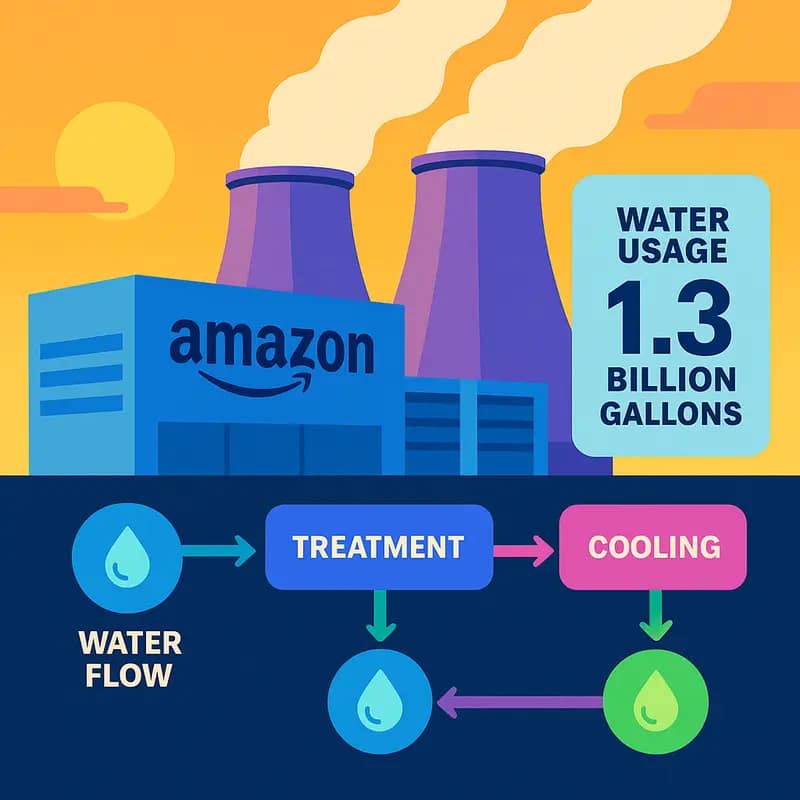
Amazon’s massive global infrastructure network has an enormous thirst, consuming billions of gallons of water annually across its operations. At the heart of this consumption are two key operational pillars: data centers and fulfillment centers.
Data centers form the backbone of Amazon’s cloud computing empire, requiring extensive cooling systems to maintain optimal server temperatures. A typical hyperscale data center can use up to 1.7 million gallons of water daily, primarily for evaporative cooling processes. In water-stressed regions, this intensive usage has sparked concerns about sustainability and resource competition with local communities.
Fulfillment centers, while less water-intensive than data centers, collectively represent another significant water footprint. These facilities require water for various purposes, including employee use, facility maintenance, and climate control systems. With over 110 million square feet of fulfillment space globally, even modest per-facility water usage adds up to substantial volumes.
Regional variations significantly impact Amazon’s water consumption patterns. In arid regions like Arizona, where water scarcity is a pressing issue, the company has had to implement specialized conservation measures and negotiate complex water rights agreements. Meanwhile, in water-rich regions, the focus shifts more toward managing wastewater quality and preventing environmental impacts.
The company’s water usage intersects with critical environmental and social considerations. As highlighted in analysis of water sustainability challenges, large-scale industrial water consumption can affect local watersheds and communities. This reality has pushed Amazon to explore innovative water management solutions, including water recycling systems and high-efficiency cooling technologies.
Tracking and measuring this massive water footprint presents its own challenges. While Amazon reports some water-related metrics in its sustainability reports, the complex nature of its operations and varying regional reporting requirements make comprehensive water accounting difficult. This complexity underscores the need for more sophisticated water monitoring and management systems across the company’s global operations.
Innovation in the Pipeline
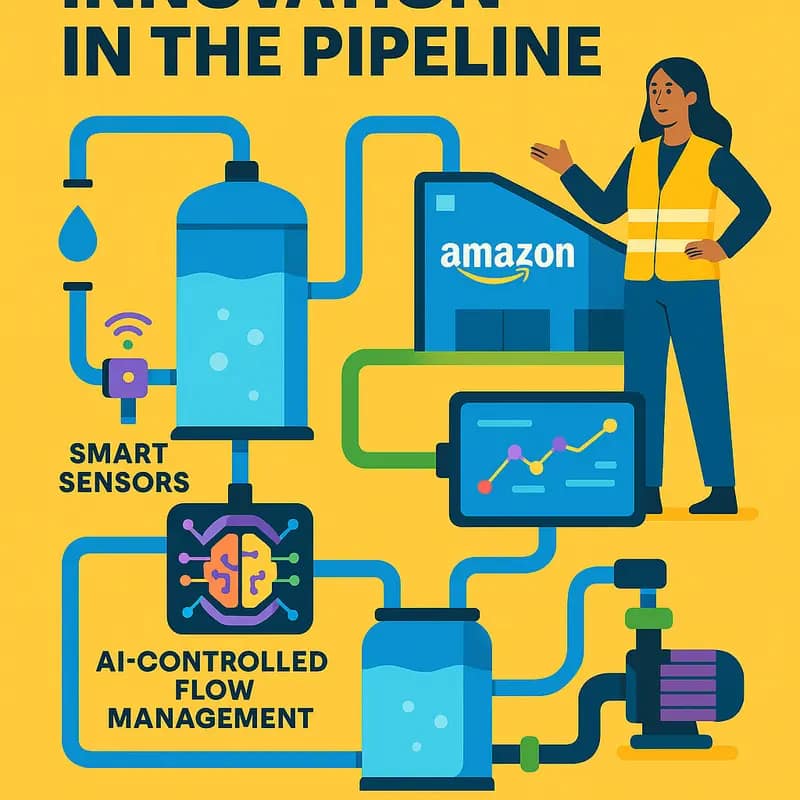
Amazon’s pursuit of water sustainability has driven the implementation of cutting-edge technologies across its global infrastructure. The tech giant’s innovative approach combines advanced monitoring systems, smart controls, and water recycling solutions to maximize efficiency while minimizing environmental impact.
At the heart of Amazon’s water management strategy lies an integrated smart metering network that provides real-time monitoring of water usage patterns. Advanced sensors and IoT devices track consumption metrics across facilities, enabling rapid detection of leaks and optimization of water systems. Through machine learning algorithms, these systems can predict maintenance needs and automatically adjust usage based on operational demands.
The company has pioneered closed-loop water systems in its data centers that recycle up to 95% of water used for cooling. These systems employ sophisticated membrane filtration technology combined with advanced chemical treatment processes to maintain water quality while dramatically reducing freshwater intake requirements.
In fulfillment centers, Amazon has deployed innovative rainwater harvesting systems integrated with smart storage and filtration infrastructure. The captured water undergoes multi-stage treatment before being repurposed for non-potable applications like landscape irrigation and cooling towers. Some facilities have implemented atmospheric water generation technology that extracts moisture from air, providing a supplemental water source while reducing strain on local resources.
Particularly noteworthy is Amazon’s investment in wastewater recycling facilities that employ cutting-edge biological treatment processes enhanced by artificial intelligence controls. These systems optimize treatment parameters in real-time, ensuring consistent water quality while minimizing energy consumption and chemical usage. The treated water meets or exceeds regulatory standards for reuse applications.
By leveraging its technological expertise and scale, Amazon continues pushing boundaries in water management innovation. The company’s solutions serve as proving grounds for emerging technologies that may help address broader water sustainability challenges. As noted in an analysis of corporate water innovation trends, such private sector leadership plays a crucial role in advancing water-efficient technologies toward mainstream adoption.
The AWS Cloud’s Water Footprint
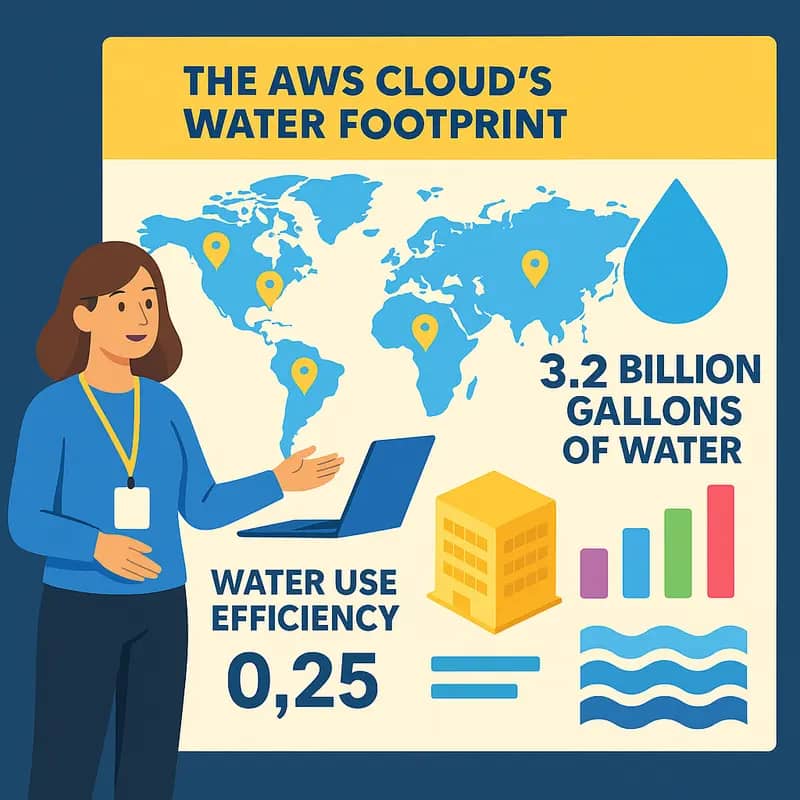
Amazon Web Services’ rapid expansion has brought unprecedented demands on water resources across its global data center network. Cooling these massive facilities requires millions of gallons daily, prompting AWS to reimagine its approach to water stewardship in the cloud computing era.
The company has implemented sophisticated water monitoring systems that track usage in real-time across its facilities. Advanced analytics help identify opportunities for optimization, while machine learning algorithms adjust cooling systems based on server loads and environmental conditions. This data-driven approach has enabled AWS to reduce water consumption per compute unit by over 35% in recent years.
Innovative cooling technologies play a central role in AWS’s water conservation strategy. The company increasingly employs air-side economization, which uses outside air to cool servers when temperatures permit. In warmer climates, advanced evaporative cooling systems maximize water efficiency through multi-stage processes that capture and reuse water wherever possible.
Beyond operational improvements, AWS has committed to water stewardship in its host communities. The company partners with local utilities to upgrade infrastructure and implement water recycling programs. In water-stressed regions, AWS invests in watershed restoration projects and groundwater recharge initiatives to offset its consumption.
Data center locations are now strategically selected based on comprehensive water risk assessments. AWS evaluates long-term water availability, climate projections, and competing demands when expanding its infrastructure. This forward-looking approach helps ensure sustainable operations while supporting the growing cloud computing needs of millions of customers.
While significant progress has been made in water efficiency, AWS continues exploring emerging technologies to further reduce its water footprint. The company is piloting next-generation liquid cooling systems and investigating waterless cooling alternatives that could revolutionize data center operations.
As detailed in How to admit value and actually overcome the economic risk of water, AWS demonstrates that responsible water management and business growth can coexist through technological innovation and community engagement.
From Warehouse to Watershed
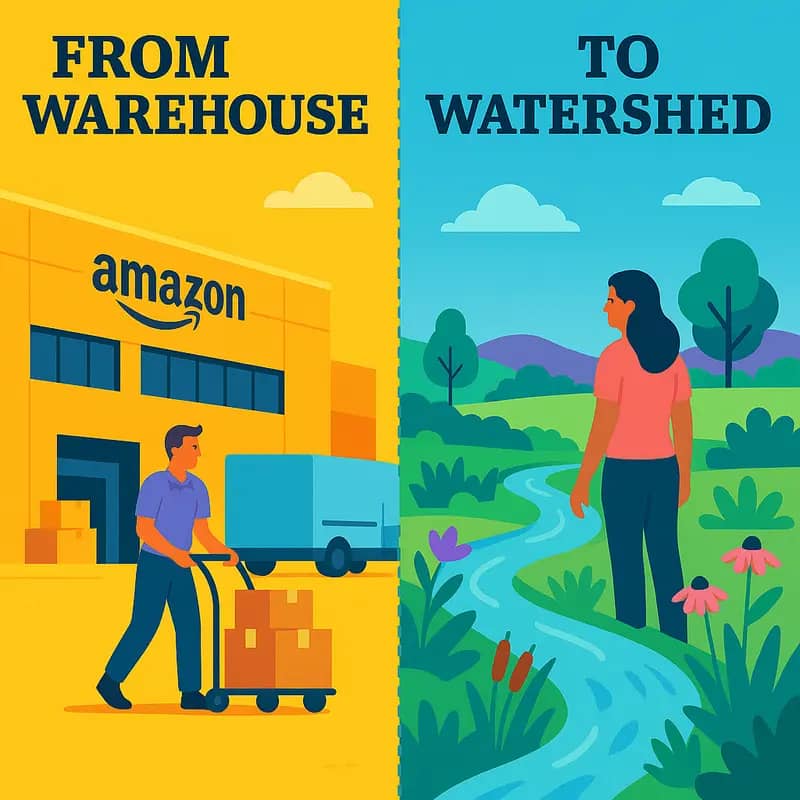
Amazon’s commitment to watershed protection extends far beyond its facility footprints, encompassing comprehensive programs that safeguard vital water resources across its operational territories. Through strategic partnerships with conservation organizations and local communities, the company has implemented watershed restoration initiatives that combine ecological preservation with community engagement.
In water-stressed regions like Arizona and California, Amazon has launched groundwater recharge programs that help replenish depleted aquifers. These initiatives utilize advanced monitoring systems to track water levels and quality while supporting natural infiltration processes. The company’s watershed protection strategy also includes extensive riparian habitat restoration, with projects spanning from the Pacific Northwest to the Southeast United States.
One noteworthy approach involves nature-based solutions that better protect cities from environmental risks. By integrating green infrastructure with traditional water management systems, Amazon creates buffer zones that filter pollutants, reduce erosion, and enhance biodiversity around its facilities.
The company’s watershed initiatives extend to source water protection, working with municipal utilities to safeguard drinking water supplies. This includes funding forest conservation efforts in key watersheds and supporting agricultural best practices that reduce runoff and contamination. These programs often yield multiple benefits, from improved water quality to enhanced climate resilience.
Beyond direct environmental impacts, Amazon’s watershed programs generate significant social value. By engaging local stakeholders and supporting community-led water stewardship efforts, the company helps build long-term capacity for sustainable water management. This collaborative approach has proven particularly effective in regions where water scarcity threatens both ecological and economic stability.
Quantifiable results demonstrate the initiative’s success: restored wetlands now filter millions of gallons annually, while protected forestlands help regulate water flow across seasons. Through these efforts, Amazon continues to evolve from a water consumer to a watershed guardian, setting new standards for corporate water stewardship.
The Water-Energy Nexus
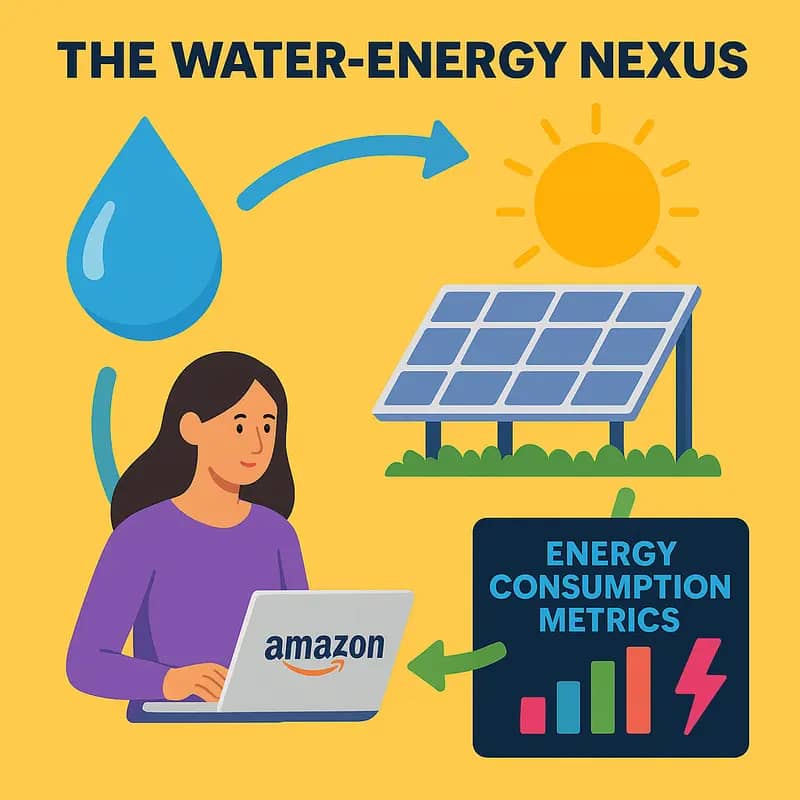
At the intersection of Amazon’s sustainability initiatives lies a complex balancing act between water conservation and renewable energy goals. The company’s data centers, which form the backbone of its cloud computing services, require substantial amounts of water for cooling while simultaneously demanding massive amounts of electricity to operate.
Amazon has pioneered innovative approaches to this water-energy nexus challenge. By implementing closed-loop cooling systems, the company reuses water multiple times before treatment, significantly reducing freshwater consumption. These systems, while energy-intensive, are powered increasingly by on-site renewable energy installations, creating a synergistic relationship between water and energy management.
The company’s commitment to reaching net-zero carbon emissions by 2040 has spurred investments in water-efficient technologies that minimize energy usage. For example, their newer data centers utilize advanced evaporative cooling systems that automatically adjust based on local climate conditions, optimizing both water and energy consumption. This intelligent approach to resource management demonstrates how water and energy efficiency can be mutually reinforcing rather than competing priorities.
Beyond data centers, Amazon’s fulfillment operations showcase another dimension of the water-energy nexus. The company has begun deploying solar panels atop warehouses, coupling them with rainwater harvesting systems. This dual-purpose infrastructure not only generates clean electricity but also reduces stormwater runoff and provides a supplementary water source for facility operations.
Perhaps most notably, Amazon’s water stewardship initiatives directly support its renewable energy goals. The company’s investments in watershed protection help maintain hydroelectric power reliability in regions where it sources renewable energy. This holistic approach, linking water conservation to clean energy generation, exemplifies how modern corporations can transform environmental challenges into opportunities for integrated sustainability solutions.
Particularly relevant to their strategy is their focus on data-driven optimization, as explored in-depth here, which allows them to continuously refine the balance between water usage and energy consumption across their global operations.
Digital Solutions for Physical Challenges
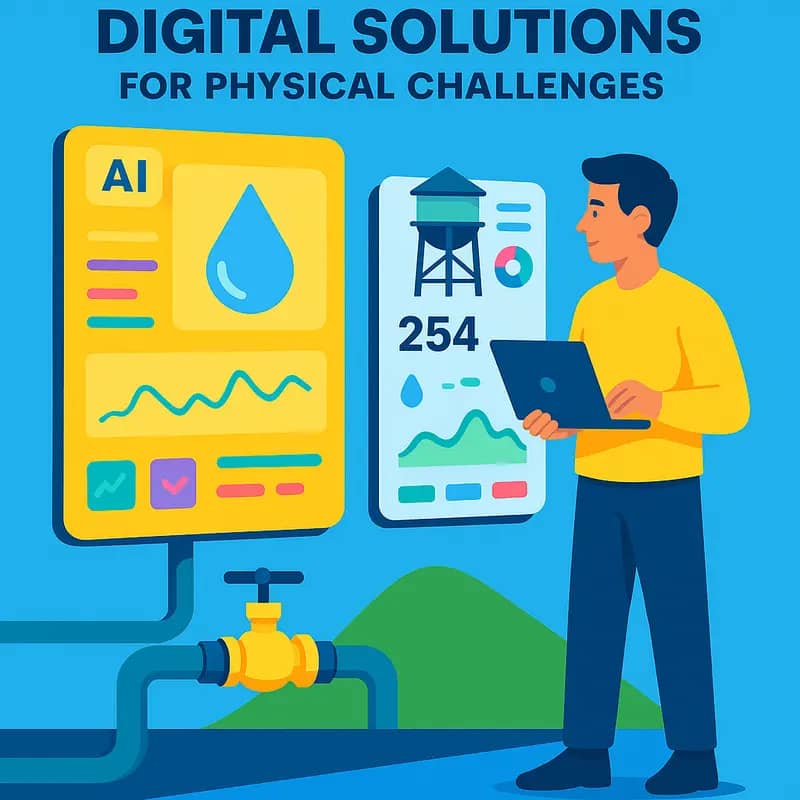
Amazon’s commitment to water sustainability has driven the company to embrace cutting-edge digital technologies across its operations. Through strategic deployment of artificial intelligence, Internet of Things sensors, and advanced analytics platforms, the tech giant has revolutionized how it monitors and manages water resources.
At the heart of Amazon’s digital water management approach lies a sophisticated network of IoT sensors installed throughout its facilities. These sensors continuously collect real-time data on water flow rates, pressure levels, quality parameters, and consumption patterns. By leveraging AI-powered predictive analytics, Amazon can detect subtle anomalies that might indicate leaks or inefficiencies before they become major issues.
The company’s machine learning algorithms analyze historical usage data alongside external factors like weather patterns and seasonal variations to optimize water allocation across different operational needs. This smart forecasting helps balance water demands between data center cooling, landscaping, and facility maintenance while identifying opportunities for conservation.
Particularly noteworthy is Amazon’s implementation of digital twin technology for water infrastructure modeling. These virtual replicas enable engineers to simulate different scenarios and test operational changes without risking disruption to actual systems. The digital twins also facilitate preventive maintenance by highlighting areas of potential stress or deterioration.
This technological framework ties directly into Amazon’s broader environmental monitoring systems, with water data feeding into comprehensive sustainability dashboards. The integration allows facilities managers to make informed decisions that consider both immediate operational needs and long-term conservation goals.
Recent innovations include the development of smart irrigation systems that automatically adjust water distribution based on soil moisture content and weather forecasts. The company has also piloted blockchain solutions for enhanced transparency in water quality tracking and reporting.
Perhaps most significantly, Amazon’s digital water management platform enables granular measurement of water reuse and recycling efforts, helping facilities optimize their water circularity strategies. The system tracks treated wastewater flows and quality metrics, ensuring maximum utilization of reclaimed water while maintaining strict compliance with regulatory standards.
Community Impact and Engagement
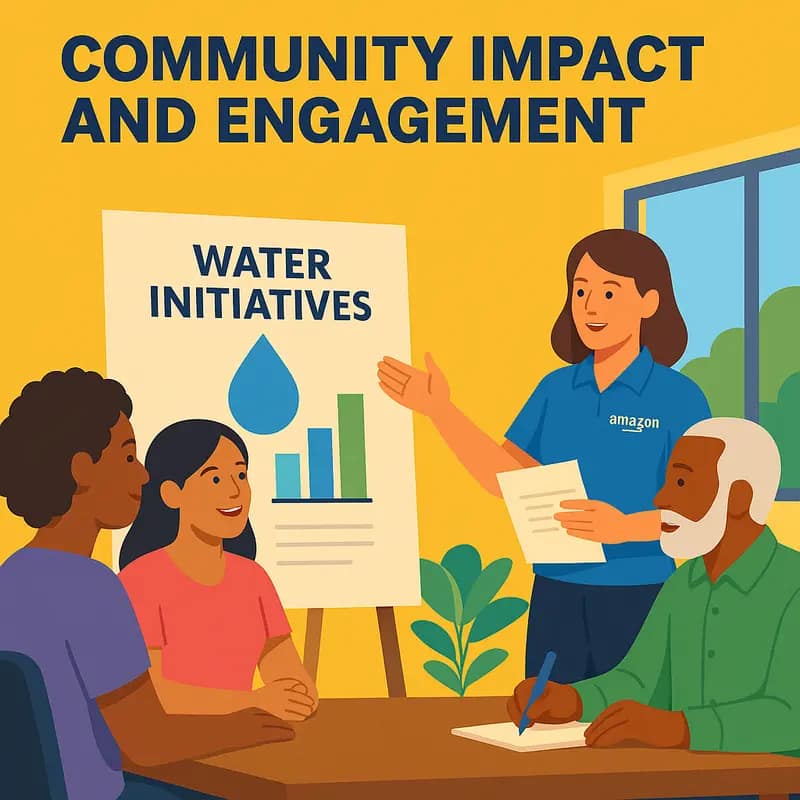
Amazon’s water footprint extends far beyond its data centers and fulfillment facilities, directly affecting the communities where it operates. The tech giant’s approach to water stewardship increasingly emphasizes collaborative solutions and transparent dialogue with local stakeholders.
In water-stressed regions like Arizona and California, Amazon partners with municipal utilities to implement innovative water recycling programs. Rather than competing for limited freshwater resources, the company has invested in infrastructure that allows treated wastewater to be reused for cooling systems and landscape irrigation. This reduces pressure on local aquifers while providing communities with upgraded water treatment capabilities.
Amazon’s community engagement strategy centers on education and capacity building. The company sponsors water conservation workshops in schools near its facilities and provides technical expertise to help local utilities optimize their operations. In India, where water scarcity affects millions, Amazon supports rainwater harvesting projects that benefit both its operations and neighboring communities.
Yet challenges remain in balancing corporate water needs with community interests. Environmental groups have questioned the company’s water usage permits in some locations, leading Amazon to increase its transparency around water consumption data and conservation targets. The company now regularly publishes detailed water stewardship reports and hosts community forums to address concerns.
Particularly noteworthy is Amazon’s watershed protection initiative, which extends beyond immediate operational boundaries. Through partnerships with conservation organizations and local governments, the company helps restore degraded waterways and protect critical water sources. These efforts demonstrate a growing recognition that corporate water sustainability requires investment in watershed-level solutions.
As discussed in https://dww.show/how-to-ensure-energy-and-carbon-resilient-projects-with-a-simple-screening-tool/, Amazon employs comprehensive screening tools to evaluate the community and environmental impacts of new projects. This systematic approach helps identify potential water-related conflicts early and develop appropriate mitigation strategies.
Moving forward, Amazon’s community engagement efforts increasingly focus on building resilience against climate change impacts. The company works with local planners to strengthen water infrastructure and develop emergency response protocols for extreme weather events.
Future Water Strategies

Amazon’s trajectory toward water sustainability is taking shape through ambitious commitments and innovative technological solutions. The company has pledged to become water positive by 2030, meaning it will return more water to communities than it consumes in its operations. This bold initiative builds on the foundations laid by current conservation efforts while introducing next-generation approaches to water management.
At the core of Amazon’s future water strategy lies an advanced data analytics framework that will monitor real-time water usage across all facilities. Machine learning algorithms will optimize water consumption patterns, predict maintenance needs, and identify opportunities for increased efficiency. The company is also developing smart infrastructure systems that can automatically adjust water usage based on environmental conditions and operational demands.
In its data centers, which account for a significant portion of water consumption, Amazon is exploring innovative cooling technologies that could reduce water usage by up to 70% compared to traditional systems. These include direct-to-chip liquid cooling and advanced air-side economization techniques that leverage natural ambient conditions to minimize water requirements.
The company’s water positive commitment extends beyond mere conservation. Amazon is investing in watershed restoration projects and developing green infrastructure solutions that will enhance natural water systems. Plans include the implementation of large-scale rainwater harvesting systems, groundwater recharge initiatives, and the creation of wetland buffers near major facilities.
To ensure accountability and transparency in these efforts, Amazon is establishing a comprehensive water stewardship framework aligned with international standards. This framework will include regular third-party audits, detailed public reporting of water metrics, and engagement with water policy initiatives at local and global levels.
Recognizing the critical link between water sustainability and climate action, Amazon’s future strategy integrates water management with its broader environmental goals. The company is exploring ways to reduce the water intensity of its renewable energy projects and implementing circular water systems that minimize waste while maximizing reuse opportunities.
These forward-looking initiatives represent a fundamental shift in how Amazon approaches water resource management, moving from a traditional consumption model to a regenerative approach that prioritizes long-term sustainability and community resilience.
The Hidden Water Footprint
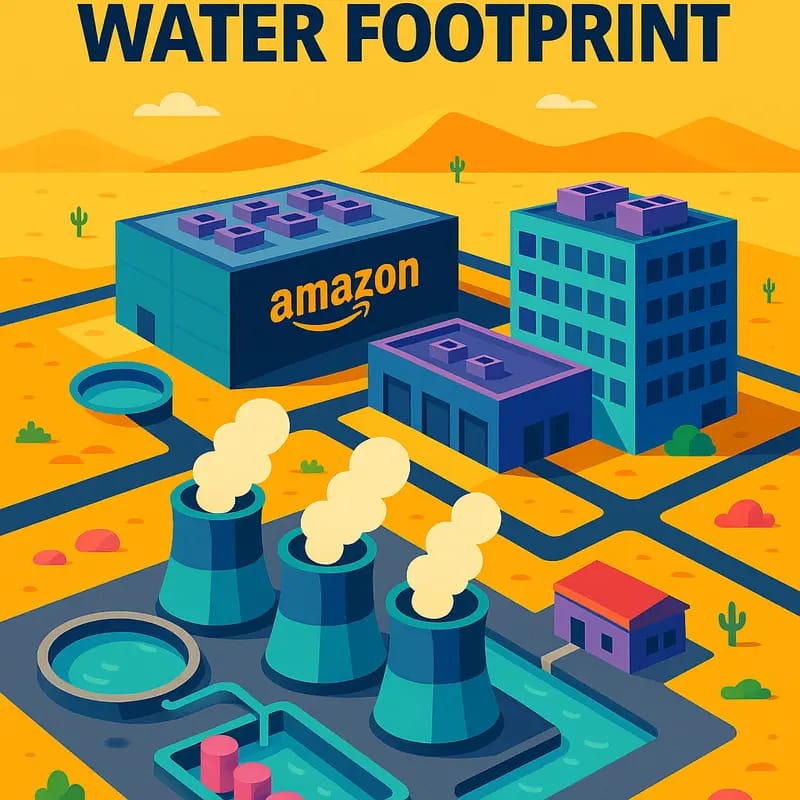
Amazon’s sprawling global infrastructure demands an astronomical volume of water – a resource requirement that often goes unnoticed behind the digital facade. At the heart of this consumption are the company’s vast data centers, which require millions of gallons annually for cooling their servers and maintaining optimal operating conditions. These facilities, powering everything from cloud computing to streaming services, represent one of the largest segments of Amazon’s water footprint.
Beyond the data centers, the company’s fulfillment network presents another significant water-intensive operation. From the basic requirements of facility maintenance to specialized processes like temperature control and sanitation, each warehouse consumes substantial amounts of water daily. The scale becomes particularly striking when multiplied across Amazon’s global network of over 1,000 fulfillment centers.
This massive water dependency has become both a challenge and a catalyst for innovation. The company’s quest for water sustainability has driven the development of sophisticated water management systems and conservation technologies. For instance, their data centers have pioneered closed-loop cooling systems that significantly reduce water waste, while some facilities have implemented advanced water recycling programs that can reuse up to 80% of their water intake.
The complexity of managing this water footprint extends beyond direct consumption. The company must navigate local water rights, community impacts, and increasingly stringent environmental regulations. In water-stressed regions, Amazon’s presence can strain local resources, necessitating careful balancing of operational needs with community sustainability.
Yet, within these challenges lies opportunity. Amazon’s scale and resources position it to pioneer water-efficient technologies that could benefit industries far beyond e-commerce. Their investments in water innovation are already yielding promising developments in areas like smart metering, predictive maintenance, and water recycling systems. These advancements align with broader sustainability goals while offering potential solutions to global water management challenges.
Engineering Water Efficiency
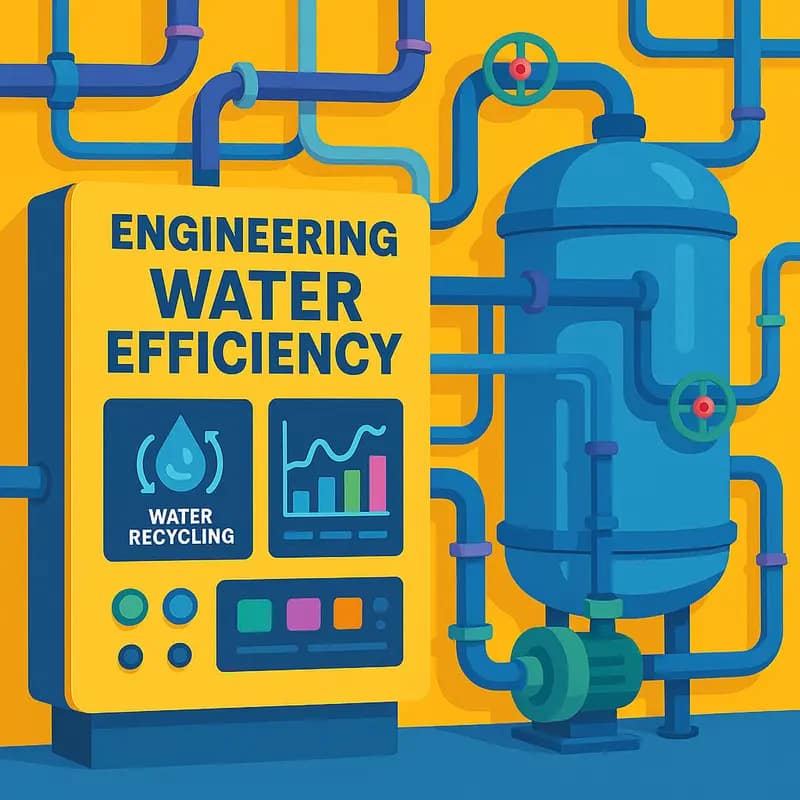
Amazon’s relentless drive for water efficiency has spawned groundbreaking technological innovations across its vast network of facilities. At the heart of these advances lies an integrated smart monitoring system that tracks water consumption in real-time through thousands of IoT sensors. This granular data feeds sophisticated machine learning algorithms that continuously optimize water usage patterns.
The company’s most impactful engineering achievement is its closed-loop cooling system for data centers, which recycles up to 80% of water used in cooling operations. Through advanced membrane filtration and UV treatment processes, wastewater is purified to meet stringent quality standards before recirculation. This system alone has helped Amazon reduce its water intensity metrics by 35% in key facilities.
In fulfillment centers, automated cleaning systems utilize electrostatic sprayers and precision nozzles that minimize water waste while maintaining sanitation standards. Smart irrigation controls for landscaping leverage weather data and soil moisture sensors to deliver precisely the right amount of water. The technology adapts watering schedules based on real-time environmental conditions, reducing outdoor water consumption by over 40%.
Perhaps most innovative is Amazon’s water-conscious approach to construction and retrofitting. The company has developed modular systems that enable rapid deployment of water recycling infrastructure across new and existing facilities. These prefabricated units integrate seamlessly with building management systems while requiring minimal downtime for installation.
AI-powered predictive maintenance helps identify potential leaks and equipment issues before they result in water waste. The system analyzes patterns in flow rates, pressure, and water quality metrics to flag anomalies that could indicate inefficiencies. This proactive approach has helped Amazon prevent millions of gallons in water losses.
The confluence of these engineering solutions demonstrates how technological innovation can dramatically reduce industrial water footprints. Through careful system design and relentless optimization, Amazon continues pushing the boundaries of what’s possible in water efficiency.
As detailed in how water trading unbelievably killed one million fishes and a river, responsible water management requires both technological innovation and careful consideration of broader environmental impacts.
The AWS Water Innovation Lab

At the heart of Amazon’s water sustainability efforts lies the AWS Water Innovation Lab, where cloud computing meets environmental stewardship. This state-of-the-art facility harnesses the power of artificial intelligence and machine learning to revolutionize how we monitor, analyze, and optimize water usage across global operations.
The lab’s centerpiece is an integrated water analytics platform that processes billions of data points from sensors deployed throughout Amazon’s facilities. Advanced algorithms detect usage patterns, predict maintenance needs, and identify optimization opportunities in real-time. This wealth of data enables unprecedented insights into water consumption behaviors and conservation potential.
One of the lab’s breakthrough developments is a predictive modeling system that anticipates water demand across different facility types and geographical locations. By analyzing historical usage data alongside variables like weather patterns, occupancy rates, and seasonal trends, the system helps facility managers implement proactive conservation measures before consumption peaks occur.
The lab has also pioneered innovative approaches to wastewater treatment monitoring. Smart sensors and AI-powered analytics track water quality parameters continuously, enabling rapid response to anomalies and optimization of treatment processes. This not only ensures regulatory compliance but also maximizes water recycling opportunities.
Beyond internal applications, the lab serves as an incubator for water management solutions that benefit the broader community. Through partnerships with utilities, municipalities, and research institutions, AWS shares its technological expertise to advance sustainable water practices industry-wide. The lab’s open-source tools and datasets have already enabled numerous organizations to enhance their water conservation efforts.
Looking ahead, the lab is exploring quantum computing applications for complex hydrological modeling and developing enhanced machine learning capabilities for identifying microscopic contaminants. These cutting-edge initiatives demonstrate Amazon’s commitment to pushing the boundaries of what’s possible in water technology while maintaining a clear focus on practical, scalable solutions.
Sustainability Meets Profitability

Amazon’s ambitious water conservation initiatives are proving that environmental stewardship and financial performance can go hand in hand. Through strategic investments in water-efficient technologies and processes, the company has achieved remarkable cost savings while significantly reducing its water footprint.
By implementing advanced water recycling systems across its data centers, Amazon has cut freshwater consumption by up to 60% in these facilities. The reduced water procurement and treatment costs translate to millions in annual savings. These systems, which leverage innovative membrane technologies and smart monitoring, have a typical payback period of just 18-24 months.
In fulfillment centers, Amazon’s water optimization program combines IoT sensors, predictive analytics, and efficient fixtures to minimize waste. Smart irrigation systems and rainwater harvesting reduce landscaping water use by 80%, while water-efficient restroom facilities cut consumption by 40%. These improvements generate substantial cost benefits through lower utility bills and reduced maintenance requirements.
The company’s investment in water-sensitive cooling technologies for its AWS infrastructure has been particularly impactful. By utilizing hybrid cooling systems that automatically switch between air and water cooling based on environmental conditions, Amazon optimizes both water usage and energy consumption. This dual benefit amplifies the return on investment while advancing sustainability goals.
Perhaps most notably, Amazon’s water initiatives have created positive ripple effects throughout its supply chain. By helping suppliers implement water-saving technologies, the company reduces upstream costs that would otherwise be passed on. This collaborative approach strengthens vendor relationships while promoting broader industry adoption of sustainable practices.
The measurable success of these programs demonstrates that water conservation can be a powerful driver of both environmental and financial performance. As Amazon continues to scale these solutions across its global operations, the compounding benefits make a compelling case for other corporations to follow suit.
Global Water Infrastructure Investment
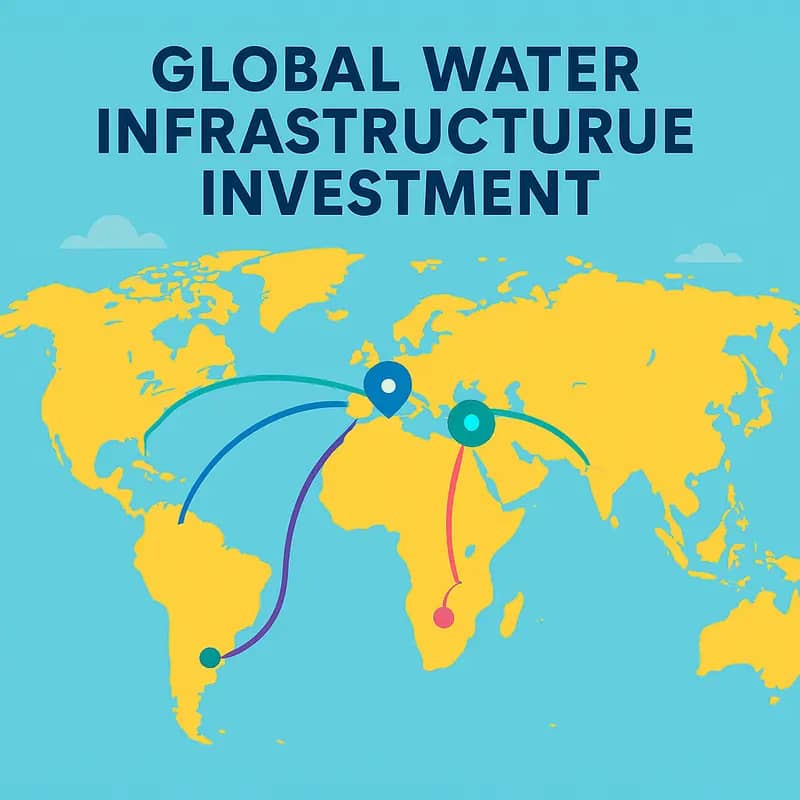
Amazon’s commitment to water sustainability is powerfully demonstrated through its strategic infrastructure investments spanning multiple continents. The tech giant has pioneered an innovative approach that combines centralized water recycling facilities with distributed treatment systems across its global network of data centers and fulfillment centers.
In water-stressed regions, Amazon has invested heavily in advanced water recovery and reuse technologies. These systems capture, treat, and recycle process water and cooling tower blowdown, achieving recovery rates above 80% in many locations. The company has also deployed smart metering and real-time monitoring systems across its facilities, enabling predictive maintenance and rapid leak detection.
Particularly noteworthy is Amazon’s investment in natural infrastructure solutions, aligning with emerging trends in sustainable water management. The company has funded watershed restoration projects and green infrastructure initiatives that enhance water quality while providing natural flood control benefits. These nature-based solutions, when combined with traditional gray infrastructure, have proven more cost-effective and resilient than conventional approaches alone.
Amazon’s infrastructure strategy extends beyond its operational footprint through strategic community partnerships. In water-scarce regions, the company has co-invested in municipal water treatment facilities, helping modernize aging infrastructure while securing reliable water access for its operations. This collaborative approach, detailed at https://dww.show/how-to-solve-the-wastewater-riddle-in-6-steps/, has created win-win scenarios for both Amazon and local communities.
The company’s water infrastructure investments are carefully prioritized using a sophisticated risk assessment framework that considers factors like local water stress, regulatory requirements, and climate change projections. This data-driven approach ensures capital is deployed where it can deliver the greatest impact, both environmentally and operationally.
Looking ahead, Amazon continues to expand its water infrastructure portfolio, with a particular focus on innovative technologies that can reduce water intensity while improving operational efficiency. These investments not only support the company’s sustainability goals but also position it to better manage water-related risks in an increasingly water-constrained world.
The Water Data Revolution

Amazon’s transformation of water management through data analytics and artificial intelligence represents a watershed moment in corporate water stewardship. The tech giant has deployed an extensive network of IoT sensors across its global facilities, creating an unprecedented real-time view of water consumption patterns, quality metrics, and system performance.
At the heart of this data revolution lies a sophisticated machine learning pipeline that processes billions of daily data points. The system can detect microscopic leaks before they become visible, predict maintenance needs weeks in advance, and automatically optimize water circulation systems based on facility demands. Learn more about revolutionizing water management through big data.
Beyond operational efficiency, Amazon’s AI models have pioneered new approaches to water conservation. By analyzing historical usage data alongside weather patterns, occupancy rates, and cooling demands, the system dynamically adjusts water allocation across different facility zones. This predictive capability has enabled Amazon to reduce water consumption by up to 30% in data centers while maintaining optimal cooling performance.
The company has also developed advanced analytics tools that provide unprecedented visibility into water quality parameters. Real-time monitoring combined with AI-powered anomaly detection helps identify potential contamination events or treatment system failures before they impact operations. This proactive approach has significantly reduced water-related operational disruptions while ensuring consistent compliance with environmental standards.
Perhaps most significantly, Amazon’s water data platform enables precise measurement and verification of conservation initiatives. Every drop saved can be quantified and tracked, creating accountability for sustainability goals and helping identify the most effective water-saving investments. This data-driven approach has transformed water management from an operational necessity into a strategic advantage, setting new standards for corporate water stewardship in the digital age.
Partnership Ecosystem
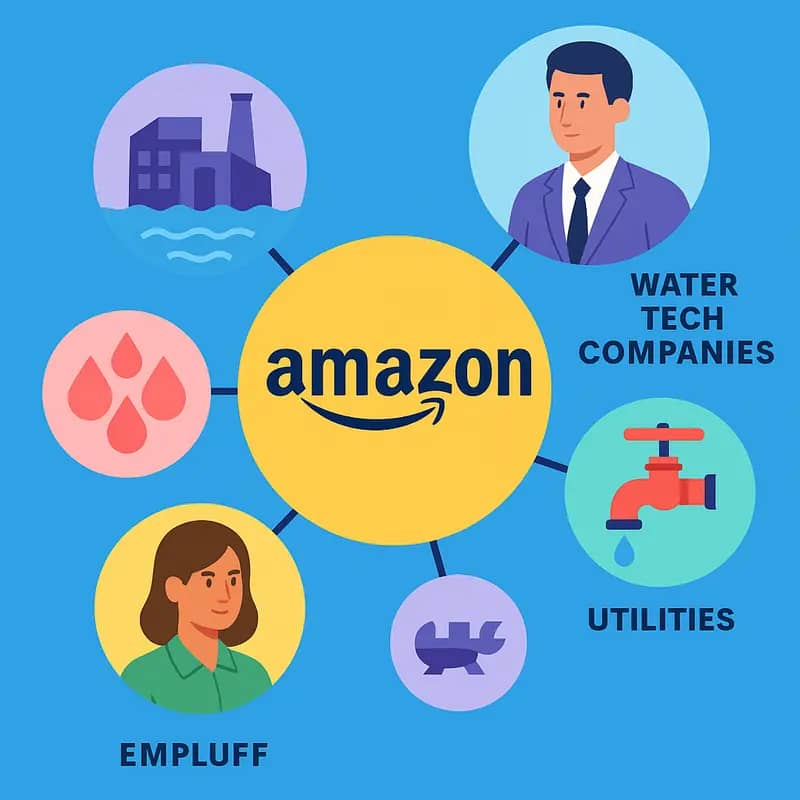
Amazon’s commitment to water sustainability extends far beyond its internal operations through a carefully cultivated network of strategic partnerships. The tech giant has forged deep collaborations with utilities and water technology providers to accelerate innovation and scale sustainable solutions across its vast operational footprint.
At the core of these partnerships lies Amazon’s data-driven approach to water management. Building on its expertise in leveraging AI and analytics, the company works closely with utilities to implement smart metering systems and develop predictive maintenance protocols. These collaborations enable real-time monitoring of water consumption patterns and early detection of potential issues across Amazon’s facilities.
The company’s partnership model emphasizes technology validation and rapid deployment. Rather than developing water technologies in-house, Amazon strategically partners with innovative solution providers to test and scale promising technologies. This approach has led to successful implementations of advanced water treatment systems, water recycling technologies, and efficiency solutions across its data centers and fulfillment facilities.
Amazon’s engagement with utilities goes beyond traditional customer-supplier relationships. The company actively participates in utility-led water conservation programs and helps shape water management policies in regions where it operates. Through these partnerships, Amazon has helped modernize water infrastructure and implement smart water management practices that benefit entire communities.
These collaborations have yielded measurable results in water efficiency and conservation. Partner utilities report significant improvements in water management capabilities, while technology providers gain valuable real-world validation of their solutions. The partnership ecosystem has also fostered knowledge sharing and best practices across different regions and facilities, creating a multiplier effect that extends beyond Amazon’s direct operations.
Looking ahead, Amazon continues to expand its partnership network, focusing on emerging technologies in water recycling, advanced treatment, and digital water management. These relationships position the company to not only meet its own sustainability goals but also to influence broader industry practices in water stewardship.
Future Water Leadership
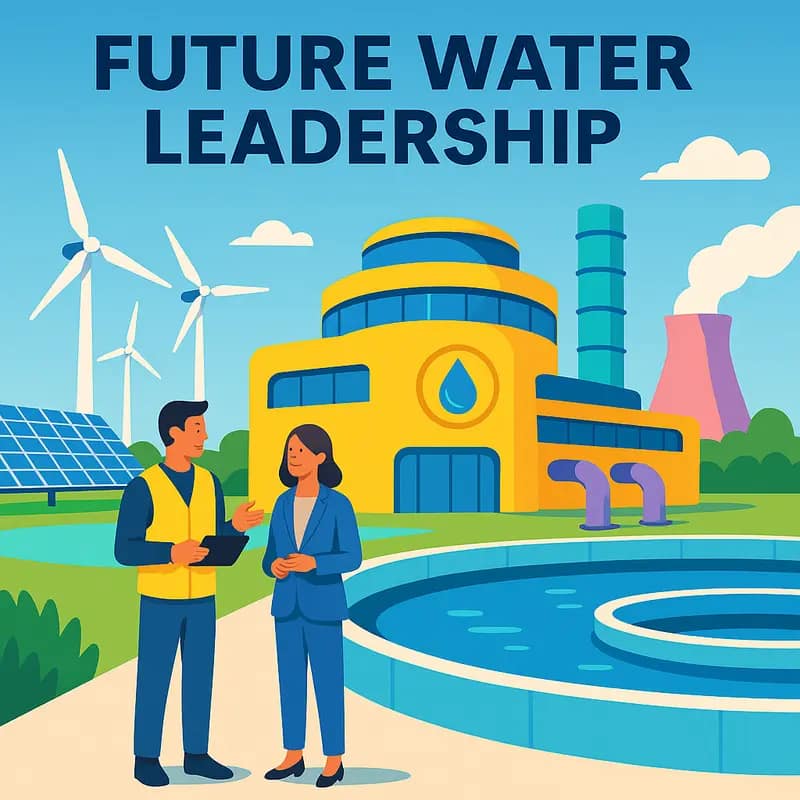
Amazon’s trajectory in water technology and management signals a transformative future for corporate water stewardship. The company’s massive scale and technological capabilities position it to drive industry-wide changes in how businesses approach water sustainability.
Predictions indicate Amazon will leverage advanced AI and machine learning to optimize water usage across its operations. These systems will likely evolve to predict maintenance needs, detect leaks instantly, and automatically adjust water consumption based on real-time conditions. The company’s data centers, which require significant cooling, will become showcases for next-generation water recycling and thermal management technologies.
Beyond its operations, Amazon is poised to shape water technology markets through strategic investments and partnerships. The company’s cloud computing infrastructure could become the backbone for a new generation of smart water management tools, enabling real-time monitoring and automated decision-making across entire watersheds. As explored in how to leverage water risk assessment to unlock business opportunities, such capabilities will be crucial for future water management.
Amazon’s influence will likely extend into policy and regulatory frameworks. Its water management practices could become de facto industry standards, particularly in data center operations and large-scale logistics facilities. The company’s commitment to water-positive operations by 2030 will necessitate innovations in water recycling, stormwater management, and watershed restoration that other corporations will seek to replicate.
The company’s future impact on water technology will likely focus on democratizing access to advanced water management tools. Just as Amazon Web Services transformed cloud computing, the company could develop platforms that make sophisticated water monitoring and conservation technologies accessible to smaller businesses and communities.
This leadership role carries significant responsibility. Amazon’s decisions about water technology investments and management practices will influence how other corporations approach water stewardship. Success in this arena could catalyze a broader corporate movement toward water-positive operations, while setbacks could slow industry-wide progress toward sustainable water management.
Final words
Amazon’s journey through the complex landscape of water management reveals a compelling narrative of challenge and innovation. As the tech giant continues to expand its global footprint, its approach to water sustainability offers valuable lessons for water industry leaders. The company’s integration of advanced technologies with environmental stewardship demonstrates that growth and sustainability can coexist, albeit with careful planning and significant investment. Yet, questions remain about the long-term sustainability of water-intensive tech operations in a water-stressed world. The success of Amazon’s water initiatives will likely influence how other corporations approach their water management strategies in the coming decades. For water entrepreneurs and executives, Amazon’s experience underscores the critical importance of investing in innovative solutions while maintaining strong relationships with local communities and watersheds. As we look to the future, the company’s evolving water strategy will continue to provide valuable insights for those navigating the intersection of technology, business, and environmental stewardship.
Get the Water Sector’s Pulse weekly for free: subscribe to my Newsletter ➡️
About us
I offer (hopefully!) unique and insightful coverage of the water industry by combining my hard-earned technical expertise with engaging storytelling. If you haven’t yet, it might be time for you to subscribe to the podcast, the youtube channel and/or the newsletter!
(I’d do it if I were you, but I’m slightly biased 😉)

